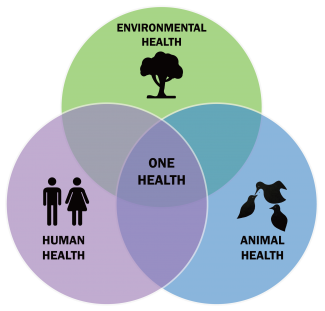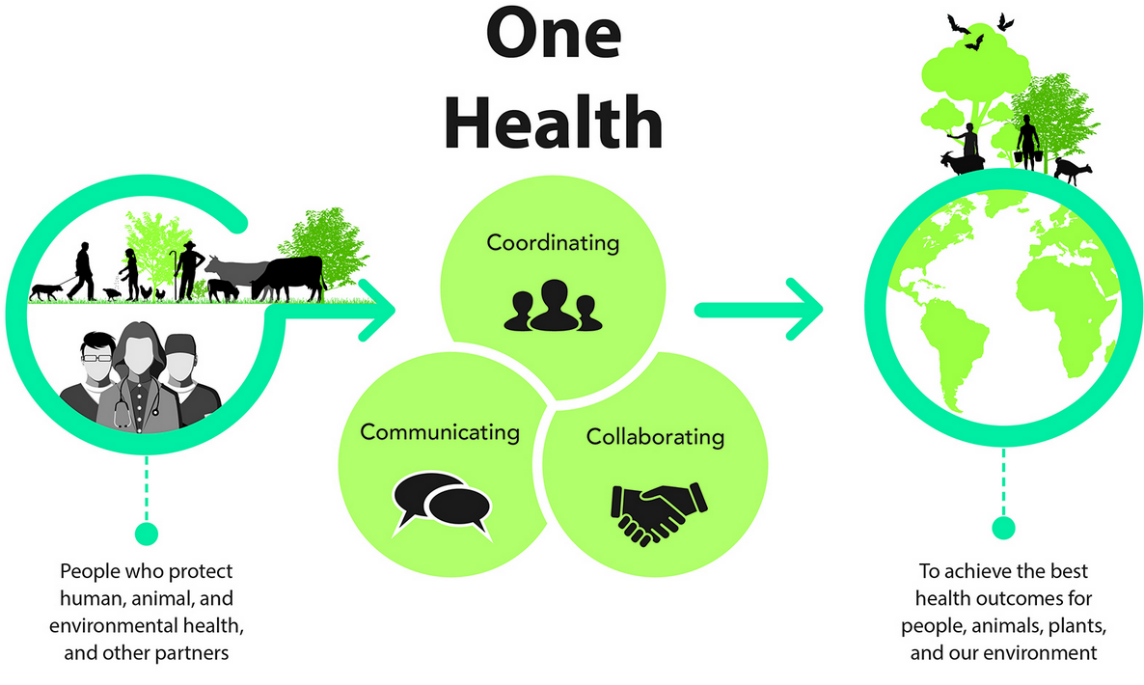ONE HEALTH APPROACH
2020 MAR 27
Mains >
Social justice > Health > Public health system

IN NEWS:
The COVID-19 outbreak shows how human, animal and environmental health requires a coordinated ‘One Health’ approach.
WHAT IS 'ONE HEALTH'?
- 'One Health' is an approach to designing and implementing programmes, policies, legislation and research in which multiple sectors communicate and work together to achieve better public health outcomes.
- One Health is a collaborative, multisectoral, and trans-disciplinary approach - working at local, regional, national, and global levels - to achieve optimal health and well-being outcomes recognizing the interconnections between people, animals, plants and their shared environment.
- One Health is not a new concept, but it has become more important in recent years. This is because many factors have changed interactions between people, animals, plants, and our environment.
NEED FOR 'ONE HEALTH' APPROACH:
- Expansion of human populations:
- Human populations are growing and expanding into new geographic areas. As a result, more people live in close contact with wild and domestic animals, both livestock and pets.
- Animals play an important role in our lives, whether for food, fiber, livelihoods, travel, sport, education, or companionship. Close contact with animals and their environments provides more opportunities for diseases to pass between animals and people.
- Human-induced changes on the planet:
- The earth has experienced changes in climate and land use, such as deforestation and intensive farming practices. Disruptions in environmental conditions and habitats can provide new opportunities for diseases to pass to animals.
- Increased mobility:
- The movement of people, animals, and animal products has increased from international travel and trade. As a result, diseases can spread quickly across borders and around the globe.
HOW DOES ‘ONE HEALTH’ APPROACH WORK?
- One Health is gaining recognition globally as an effective way to fight health issues at the human-animal-environment interface, including zoonotic diseases.
- It can be applied by involving experts in human, animal, environmental health, and other relevant disciplines and sectors in monitoring and controlling public health threats and to learn about how diseases spread among people, animals, plants, and the environment. Successful public health interventions require the cooperation of human, animal, and environmental health partners. Professionals in human health (doctors, nurses, public health practitioners, epidemiologists), animal health (veterinarians, paraprofessionals, agricultural workers), environment (ecologists, wildlife experts), and other areas of expertise need to communicate, collaborate on, and coordinate activities.
- Other relevant players in a One Health approach could include law enforcement, policymakers, agriculture, communities, and even pet owners.

ONE HEALTH AND INDIA:
- India is among the top geographical hotspots where zoonotic diseases are major public health issue causing high burden of morbidity and mortality.
- High priority zoonotic diseases like Brucellosis have been emerged from Haryana to Goa, incidence and prevalence of occupational zoonotic disease like Anthrax have affected human health throughout.
- Similarly, Bovine tuberculosis (bTB) is a chronic disease of cattle that impacts productivity and represents a major public health threat and is considered endemic in India.
- Further, being among the highest bacterial disease burden in the world, antibiotics, therefore, have a critical role in limiting morbidity and mortality and consequently Antimicrobial Resistance (AMR) has huge implications for India.
- India would do well to formulate a roadmap for the response, preparedness, and management of current regional, national and global health challenges using a One Health collaborative approach.
Measures towards One Health:
- One Health India Conference, 2019 – The conference launched India's new One Health Initiative - an intersectoral approach to tackling the most urgent health threats in India.
- One Health Centre is being established in collaboration with Maharashtra Animal and Fishery Sciences University (MAFSU), Nagpur and ICMR-National Institute of Virology, Pune.
GLOBAL EFFORTS:
- One Health Commission - It is a non-profit organization with the mission to connect individuals and create relationships across human, animal, and environmental health sectors, as well as to educate the public about these issues with the intent to improve global health.
- One Health Platform - It is a scientific reference network which unites researchers and experts of One Health to better understand and prepare for zoonotic disease outbreaks from animals to humans and antimicrobial resistance, including a better understanding of environmental factors that impact disease dynamics.
- The WHO was a partner in the 2008 establishment of a strategic One Health framework for approaching global health problems.
- In 2011, the FAO put forth a strategic action plan for One Health, which had the objective to strengthen food security by improving animal production systems and veterinary services and called for action in improving collaborations between animal, human, and environmental health sectors.
WAY FORWARD:
- COVID 19 has raised the need to integrate One Health approach in the management of public health challenges like zoonoses, anti-microbial resistance (AMR) etc.
- It should be supported by increased Research and Development (R&D) in One Health, coordination and cooperation between different ministries and departments to evolve common strategies, involvement of environmentalists and animal health specialists in evolving strategies to combat public health challenges and investments in environmental conservation and combating climate change.
|
ONE HEALTH IN ACTION: CHINA
- China conducted First Stepwise Approach to Rabies Elimination (SARE) Workshop
- In 2015, China – which has the second highest rate of human rabies deaths in the world – pledged to meet the World Health Organization’s (WHO) goal to reach zero human deaths from canine rabies by 2030.
- To better address these barriers and achieve the 2030 goal, China’s Center for Disease Control (China CDC) and the US CDC China office and headquarters staff jointly hosted a Stepwise Approach to Rabies Elimination (SARE) Workshop in Beijing.
- Experts from WHO, the Food and Agriculture Organization of the United Nations (FAO), and the World Organization for Animal Health (OIE) also participated in the workshop.
- The process allowed China to identify measurable steps needed to achieve the elimination of dog-transmitted rabies at both the national and provincial levels.
- In addition, the workshop brought together partners from human health, animal health, and public security to enhance communication, coordination, and collaboration across sectors.
|
PRACTICE QUESTION:
Q. What is ‘One Health’ approach? Examine the significance of ‘One Health’ approach in light of the recent COVID-19 pandemic.

